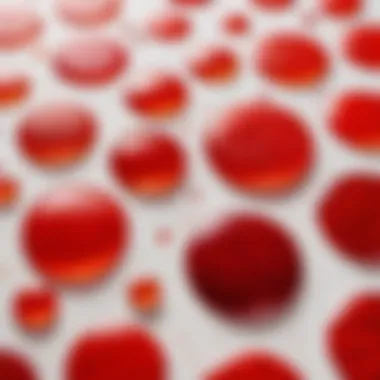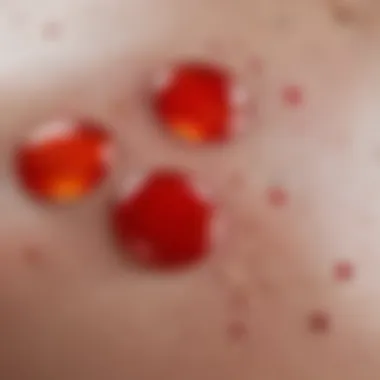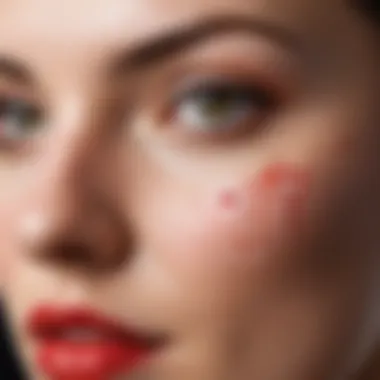Understanding Red Spots on the Skin: Causes and Care


Intro
The appearance of red spots on the skin can evoke a range of emotional responses, from concern to confusion. Understanding the underlying causes of these skin changes is essential in managing skin health effectively. This article examines the various reasons why red spots may develop, including both benign and serious conditions. We will explore diagnostic methods, treatment options, and preventative strategies that can help individuals maintain healthy skin.
Addressing red spots on the skin is crucial for everyone, as these signs can sometimes indicate a more significant health issue. Thus, this article will serve as a comprehensive guide to navigating the complexities of these skin anomalies. By gaining knowledge about red spots, readers can feel empowered to take appropriate actions and consult healthcare professionals if necessary.
It is important to approach red spots with an informed mindset. Through careful observation and understanding of symptoms, one can distinguish between harmless marks and those that could signal a health concern. This understanding is not only vital for personal health management but also contributes to responsible skincare practices.
Preamble to Red Spots
Red spots on the skin can raise alarms for many. They may signal an allergic reaction, an underlying skin condition, or something even more serious. Understanding what these red spots represent is important for making informed health choices. This section serves as a foundation for exploring the topics related to red spots, paving the way for deeper examination.
Defining Red Spots
Red spots can take various forms: they may be flat or raised, small or large, and sometimes they may itch or give discomfort. They can also appear in clusters or alone. While not every red spot indicates something alarming, their presence prompts consideration. Common definitions in dermatology describe red spots as areas of erythema, where the skin's blood vessels become dilated, leading to localized inflammation.
Prevalence and Significance
Red spots are frequently encountered in both clinical practice and among the general public. Studies show users with skin concerns often report issues related to rashes or discoloration. They can arise from a wide range of triggers, both internal and external.
The significance of understanding red spots lies in their potential to indicate more serious health issues. For example, certain autoimmune diseases can manifest through red spots on the skin. Therefore, recognizing their form, location, and accompanying symptoms becomes crucial in determining whether further medical evaluation is necessary.
In summary, red spots are a common yet sometimes misunderstood phenomenon in dermatology. By familiarizing oneself with their characteristics and significance, individuals can better navigate their skin health.
Causes of Red Spots
The causes of red spots are crucial to clarify in understanding skin health. Red spots can stem from various sources including allergic reactions, skin conditions, infections, environmental factors, and systemic diseases. This section will examine these causes, providing insight into how each can lead to the emergence of red spots, their characteristics, and treatment implications. By comprehending these causes, readers can better navigate their skin concerns and make informed decisions regarding their health.
Allergic Reactions
Common Allergens
Common allergens can provoke red spots on the skin. Substances like pollen, pet dander, certain foods, and medications are known triggers. An allergic reaction typically occurs when the immune system mistakenly identifies a harmless substance as a threat. This process can lead to inflammation and result in red spots. Recognizing these allergens is essential for prevention and management. They can often cause a fast, sometimes severe, reaction, making it crucial to identify them promptly.
- Milk
- Eggs
- Peanuts
- Tree nuts
- Fish
- Shellfish
Symptoms to Watch For
Symptoms to watch for include itching, swelling, and the appearance of hives alongside red spots. These indicators can help differentiate between various causes of skin changes. The key characteristic is that allergic symptoms can vary in severity from mild rashes to anaphylactic reactions. This variability is a significant reason to acknowledge and monitor how one’s skin responds to suspected allergens.
If you notice red spots accompanied by difficulty breathing, seek immediate medical help.
Management Strategies
Management strategies for allergic reactions focus on avoiding known triggers. Antihistamines, topical corticosteroids, and in some cases, immunotherapy may be recommended. Each strategy carries its own benefits and challenges. For instance, antihistamines are widely beneficial for alleviating symptoms, although they may not treat the underlying cause. Guidance from health professionals plays a vital role in selecting the right approach.
Skin Conditions
Psoriasis
Psoriasis is a chronic skin condition that causes red, scaly patches. Its characteristics make it an important topic in this discussion. The body's immune system mistakenly attacks healthy skin cells, resulting in rapid cell turnover and inflammation. Understanding psoriasis aids in recognizing its symptoms and triggers, which include stress, infections, and certain medications. Ignoring psoriasis can lead to more severe skin damage if not properly managed.
Eczema
Eczema, also known as atopic dermatitis, is another skin condition that can cause red spots. This condition is characterized by dry, itchy skin and can lead to secondary infections. The triggers may vary between individuals, making personalized care crucial. Eczema management often includes moisturizers and corticosteroid creams. Awareness of this condition is beneficial as it affects many at different life stages.
Rosacea
Rosacea is a common condition marked by redness and visible blood vessels, typically on the face. Its various subtypes can lead to different symptoms, including red spots. Triggers like spicy foods, heat, and stress can exacerbate rosacea symptoms, making it necessary to identify factors that provoke flare-ups for effective management. Treatments may involve topical medications and lifestyle adjustments.
Infections


Viral Infections
Viral infections can lead to red spots as part of a broader symptom profile. For example, conditions like chickenpox and measles commonly feature red spots alongside other symptoms. Understanding the role of viral infections is vital as they can spread and affect overall health. Treatment strategies often involve rest, hydration, and sometimes medication to manage symptoms.
Bacterial Infections
Bacterial infections such as impetigo can lead to localized red spots. These infections can be contagious and serious, requiring professional medical assessment. Recognizing symptoms like pus and tenderness can facilitate timely intervention. Antibiotics are typically prescribed to treat bacterial infections, underscoring the importance of seeking medical advice to prevent complications.
Fungal Infections
Fungal infections also contribute to the development of red spots. Conditions like tinea corporis (ringworm) manifest as circular, red spots. These infections thrive in warm, moist areas and may require antifungal treatments. Understanding the unique features of fungal infections helps in distinguishing them from other causes of red spots, ensuring appropriate responses are implemented.
Environmental Factors
Sun Exposure
Excessive sun exposure can result in red spots due to sunburn or other skin damage. Prolonged exposure may lead to skin cancer in severe cases. Therefore, awareness of the sun's harmful effects is far-reaching, influencing proactive skincare measures like regular application of sunscreen and protective clothing. The unique feature is that prevention starts with awareness and education about the sun's impact on skin health.
Pollution
Environmental pollution can aggravate skin conditions and may lead to red spots. Pollutants can cause oxidative stress on the skin, resulting in inflammation. The relationship between pollution and skin health highlights the importance of using protective skincare products. Understanding this connection helps in forming effective skincare routines.
Temperature Issues
Extreme temperature changes—whether hot or cold—can result in red spots. Cold temperatures can cause conditions like chilblains, while heat may lead to heat rash. Recognizing temperature-related issues allows individuals to prepare and protect their skin accordingly. Appropriate clothing and skincare products can mitigate these risks, enhancing overall skin health.
Systemic Diseases
Liver Conditions
Liver conditions may manifest as red spots on the skin. Conditions such as cirrhosis can lead to spider angiomas, which are small red spots caused by blood vessel dilation. Identifying such changes is critical as they can indicate underlying health issues that require immediate attention. Regular check-ups can help in managing liver health.
Autoimmune Disorders
Autoimmune disorders can produce a range of skin symptoms, including red spots. Conditions like lupus and dermatomyositis feature skin manifestations that must be assessed by healthcare professionals. Understanding the link between these disorders and skin changes encourages individuals to seek out further evaluation and investigate symptoms early.
Blood Disorders
Blood disorders such as thrombocytopenia can cause petechiae, which appear as small red spots resulting from bleeding under the skin. Recognizing this symptom is essential, as it may indicate more serious health issues that warrant medical attention. Understanding the implications of blood disorders can empower individuals to monitor their health better.
Clinical Assessment
Clinical assessment is a crucial aspect when addressing red spots on the skin. It involves a systematic evaluation to identify the underlying causes of these skin changes. A thorough assessment can guide appropriate treatments and prevent further complications. Understanding clinical assessment helps individuals interpret their skin conditions more accurately, which can lead to timely interventions and better outcomes.
Visual Inspection
Visual inspection is a simple yet effective initial step in clinical assessment. Dermatologists usually start this process by examining the affected area. They take note of the color, size, shape, and distribution of the red spots. The characteristics observed during this inspection can provide valuable insight into potential causes. For instance, spots that are bright red may suggest a different issue than those that are darker or purplish. Furthermore, paying attention to accompanying symptoms, such as itching or burning, can significantly narrow down the possible diagnoses.
Diagnostic Tests
In some cases, visual inspection alone does not suffice. This is where diagnostic tests come into play. They offer definitive answers by analyzing the skin or related bodily functions. Different types of tests yield unique information about the skin's condition and help in forming a precise diagnosis.
Patch Tests
Patch tests are particularly useful in identifying allergic reactions. They involve applying small amounts of allergens to the skin and observing any reactions over a few days. This process is beneficial because it helps pinpoint specific sensitivities. One key characteristic of patch tests is that they can reveal delayed allergic reactions, which might not appear immediately. This aspect makes patch tests a popular choice for diagnosing contact dermatitis. However, they can take several days to provide results, which may be seen as a disadvantage for those seeking immediate answers.
Skin Biopsy
Skin biopsy holds essential value in clinical assessments involving red spots. This procedure involves removing a small sample of skin for laboratory analysis. Its primary contribution is that it can provide concrete evidence regarding skin diseases, such as psoriasis or skin cancer. A skin biopsy's key characteristic is its ability to give a precise diagnosis by examining cellular structures. While it is a beneficial choice, it also has drawbacks, such as potential discomfort and a brief recovery time following the procedure.
Blood Tests


Blood tests also play a role in understanding skin conditions. They help identify underlying systemic issues that may cause red spots. For example, a complete blood count can reveal if there are signs of infection or anemia. One important aspect of blood tests is that they can assess markers of inflammation. This feature makes them a beneficial choice because they provide a broader perspective on the individual’s health. However, results can take time, possibly delaying the diagnosis if the doctor is awaiting these tests before making a decision.
Treatment Approaches
Topical Treatments
Topical treatments are often the first line of defense against red spots. They are applied directly to the skin, allowing for localized action. Here are some notable options:
Corticosteroids
Corticosteroids are anti-inflammatory medications. They work by reducing redness and irritation. A key characteristic of corticosteroids is their effectiveness in treating conditions such as eczema and psoriasis. They are a popular choice for reducing inflammation associated with red spots. However, long-term use may thin the skin. Therefore, it is important to use them as directed by a healthcare provider.
Moisturizers
Moisturizers play an integral role in skin health. They help to maintain hydration, which can soothe irritated skin. A significant feature of moisturizers is that they provide a barrier against environmental irritants. This can be particularly beneficial for sensitive skin. Regular use of moisturizers can enhance skin texture and reduce the severity of red spots. However, it is vital to choose products that are free from harsh chemicals to avoid further irritation.
Antihistamines
Antihistamines are effective in managing allergic reactions. These medications can alleviate itching and discomfort caused by allergens. A notable characteristic of antihistamines is their rapid action in relieving symptoms. They are a beneficial choice for red spots resulting from allergic reactions. However, they may cause drowsiness as a side effect. This is an important consideration for those needing to stay alert during the day.
Oral Medications
In some cases, oral medications may be necessary. These are especially important for systemic issues or severe skin conditions. Here are the main types of oral medications:
Antibiotics
Antibiotics are used to treat bacterial infections that can cause red spots. They are an effective choice when the condition has a known bacterial origin. A key aspect of antibiotics is their ability to prevent the spread of infection. Nevertheless, misuse of antibiotics can lead to resistance. Monitoring by a healthcare provider is vital.
Immunosuppressants
Immunosuppressants can be critical for autoimmune-related skin issues. They work by dampening the immune response, which helps decrease inflammation. The key characteristic of immunosuppressants is their effectiveness in severe cases. However, they increase susceptibility to infections. Caution is necessary when considering these medications.
Antivirals
Antivirals are used to manage viral infections that affect the skin. They are especially valuable in cases such as herpes simplex outbreaks. A key feature of antivirals is their ability to shorten the duration of symptoms. However, limitations exist. For example, they may not be effective against all viral causes of red spots.
Lifestyle Modifications
Lifestyle modifications can significantly impact skin health. Making simple changes can enhance the effectiveness of medical treatments. Here’s an overview of key lifestyle modifications:
Daily Skincare Routine
A daily skincare routine promotes healthier skin overall. It helps remove dirt and oil, preventing clogged pores. The key characteristic of a consistent routine is that it fosters a balanced skin environment. Choosing gentle cleansers and non-irritating products can improve skin conditions. A disadvantage is that it requires dedication and time.
Nutrition and Hydration
Nutrition and hydration directly affect skin health. Eating a balanced diet rich in vitamins and minerals supports skin repair. Hydration keeps the skin plump and less prone to irritation. The unique feature of good nutrition is its long-term benefits. On the downside, changing dietary habits can be challenging for some individuals.
Stress Management
Stress management techniques are important for skin health. High stress can lead to flare-ups of conditions such as eczema or psoriasis. The key aspect of stress management is its potential to improve overall well-being. Simple practices like mindfulness or regular exercise can make a difference. However, finding effective techniques may require time and experimentation.
Red spots on the skin can indicate various underlying conditions. Understanding treatment options and lifestyle modifications is essential for effective management.
Preventive Measures
Preventive measures are crucial in managing skin health, especially when it comes to red spots. Taking proactive steps can reduce the occurrence of these skin changes. Moreover, understanding how to effectively care for your skin can lead to long-term benefits. This section will explore practices that not only enhance the appearance of the skin but also minimize potential complications.
Proper Skincare Practices
Choosing the Right Products


Choosing suitable skincare products is fundamental to maintaining skin health. An essential aspect of this is understanding your skin type. Products formulated for oily skin will not work effectively on dry skin, and vice versa. Look for products that do not contain known irritants like alcohol or heavy fragrances.
One significant characteristic of these products is their hypoallergenic nature. This means they are less likely to cause an allergic reaction. Many users find this beneficial as it reduces the risk of developing red spots. However, it is essential to be aware that not every product marketed as hypoallergenic is suitable for all skin types.
Regular Skin Checks
Regular skin checks are vital in noticing changes early. This practice involves examining your skin frequently for any new or unusual spots, especially if you have a history of skin conditions. The main feature of regular checks is building awareness of what is normal for your skin.
Being familiar with your skin allows for quicker recognition of any concerning changes. This can be a significant preventive step, helping to catch issues before they escalate. The disadvantage here could be that some might overlook subtle changes, thinking they are normal, thus delaying consultation with a healthcare provider.
Sunscreen Use
Sunscreen is a crucial element in preventive care against red spots. Using sunscreen daily can protect your skin from harmful UV rays. The strength of UV protection is often measured in SPF, or sun protection factor. A higher SPF offers more protection. This characteristic makes sunscreen a popular choice for skin health.
A unique feature of modern sunscreens is their formulation with additional skincare benefits, like moisturizing properties. This can enhance skin hydration alongside protection. However, one must consider that incorrect application or insufficient quantity can lessen its effectiveness. So, it is vital to apply it generously and reapply as needed.
Understanding Skin Sensitivity
Understanding skin sensitivity is a fundamental aspect of skincare. Different individuals may react differently to products and environmental factors. Recognizing what triggers sensitivity in your skin can lead to better management of red spots. Pay attention to reactions after using new products or changing your routine. This awareness helps tailor a skincare approach that minimizes risks.
"Emphasizing prevention by understanding your skin is key to reducing problematic red spots."
By incorporating these preventive measures, you create a foundation for better skin health. This attuned approach elevates your understanding and care of your skin.
When to Seek Professional Help
Recognizing the right moment to consult a healthcare professional regarding red spots on the skin is essential for effective management. Many individuals may experience anxiety related to skin changes, which is often exacerbated by uncertainty about the underlying issues. By understanding when it is appropriate to seek professional advice, one can take proactive steps in safeguarding skin health.
Recognizing Warning Signs
It is crucial to be alert for specific warning signs that indicate the need for medical attention. These include:
- Persistent Red Spots: Spots that do not fade or improve over time.
- Increased Size or Number: A rapid increase in size or number of spots on the skin.
- Associated Symptoms: Itching, pain, or discharge accompanying the spots.
- Changes in Skin Texture: Any alteration in the texture or appearance of skin lesions.
- Systemic Symptoms: Fever, fatigue, or general malaise, which may signal a more serious underlying condition.
Each of these warning signs can indicate the necessity for a thorough exploration of the symptoms. Not all skin changes represent severe health issues, but timely evaluation reduces potential risks and can lead to significant improvements in treatment outcomes.
Approaching Healthcare Providers
When deciding to visit a healthcare provider, it is helpful to be prepared. Knowing what to expect can alleviate anxiety and make the process smoother.
What to Expect
During a visit, the healthcare provider will perform a thorough assessment. This typically includes:
- Medical History Review: Discuss past skin conditions, allergies, or other relevant health issues.
- Physical Examination: The doctor will inspect the red spots closely.
- Diagnostic Recommendations: They may suggest further tests, if necessary, like skin biopsy or blood tests.
The emphasis on a comprehensive examination ensures a solid understanding of the condition. This aspect of the visit is particularly beneficial, enabling personalized diagnosis and tailored treatment plans for the patient.
Preparing for Your Appointment
Preparation is vital for making the most out of your appointment. Here are some practical tips:
- Document Symptoms: Keep a record of when the red spots appeared and any changes observed.
- List Products Used: Note any recent skincare products or medications that may have triggered the condition.
- Prepare Questions: Think about what to ask during the appointment to maximize understanding.
Being prepared enhances the communication between you and your healthcare provider. This engagement leads to a clearer understanding of your condition and, consequently, more effective treatment options.
End
In the examination of red spots on the skin, concluding insights play a critical role in consolidating our understanding. This article highlights that red spots can manifest from various causes, ranging from benign to more severe underlying conditions. Recognizing these variations is essential for informed decision making about one’s health.
Summarizing Key Points
Throughout the article, several key aspects have been outlined:
- Diverse Causes: Red spots can arise from allergic reactions, skin conditions, infections, environmental factors, and systemic diseases. Each of these categories presents its unique set of symptoms and treatment approaches.
- Assessment Methods: Clinical assessments include visual inspections and diagnostic tests such as patch tests and biopsies. Understanding these methods aids in swift identification of the underlying issues.
- Treatment and Prevention: Treatment options range from topical applications to oral medications. Preventive measures include proper skincare and comprehending one’s skin sensitivities, which can significantly reduce the occurrence of red spots.
- When to Seek Help: It's vital to acknowledge when a visit to a healthcare provider becomes necessary. Monitoring warning signs can prevent potential complications.
Final Thoughts
By recognizing the significance of red spots, individuals can take empowered steps toward prevention and treatment. Addressing these changes early leads to better outcomes and a more profound appreciation for skin health.







